One of the most easily recognizable birds in North America, cardinals are famous for their flamboyant, red plumage, which is said to resemble the robes of a Catholic bishop. But while cardinals often visit bird feeders in summer, these cheerful birds are non-migratory, which means cardinals will stick around your garden all year long.
If you want to ensure plenty of male and female cardinals visit your feeders this winter, there are a few steps that you can take to make your space even more cardinal-friendly!
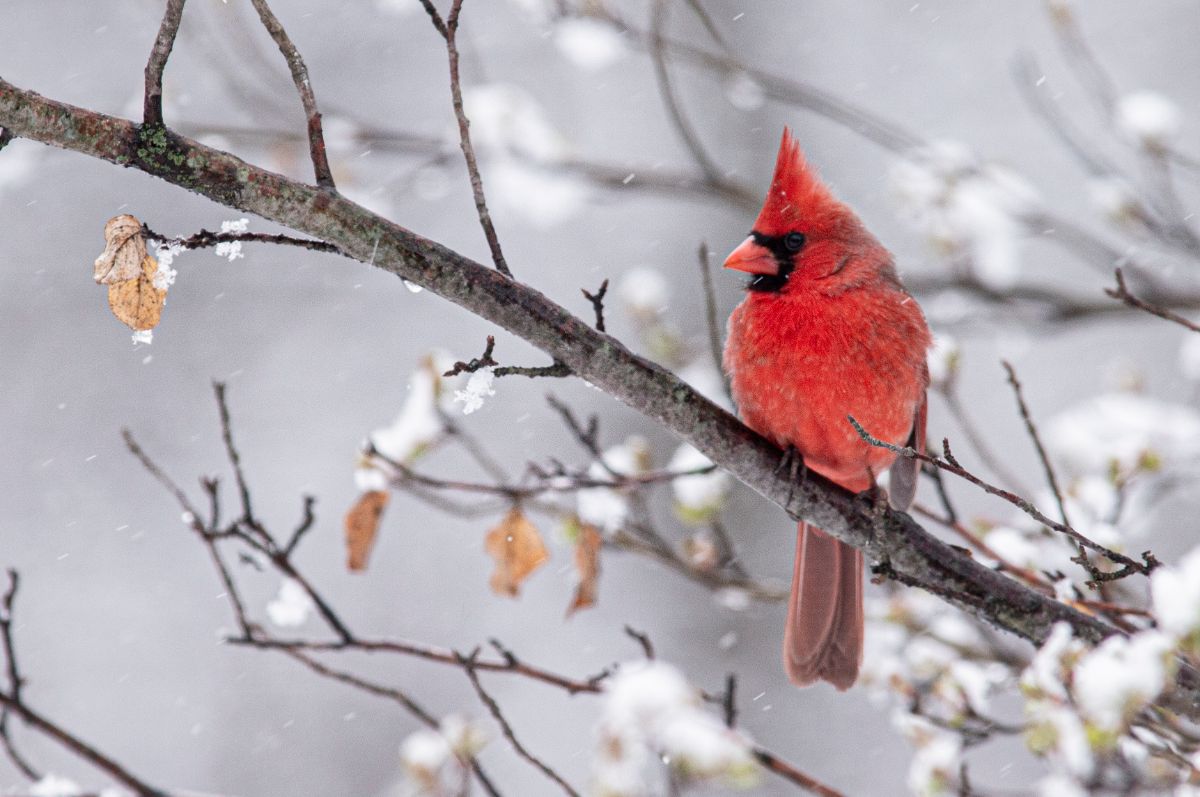
From providing the right food sources to selecting the best shelter for cardinals, this guide has everything you need to transform your backyard into a winter oasis for cardinals. And what’s more, if you lay out the proper banquet for these red birds, you’re likely to attract lots of other non-migratory birds to your garden as well, including sparrows, finches, and juncos!
Jump to:
- 10 tips to attract cardinals to your bird feeders this winter
- 1. Use the right feeders.
- 2. Feed at the right time.
- 3. Pick the right seeds.
- 4. Provide fresh water.
- 5. Put your feeding station in the right spot.
- 6. Be consistent.
- 7. Grow winter interest plants.
- 8. Keep cats indoors.
- 9. Avoid reflective surfaces.
- 10. Go organic.
- Frequently asked questions
- What do cardinals look like in the winter?
- Where do cardinals go at night in the winter?
- Do cardinals mate for life?
- Why does a cardinal keep trying to get in my window?
- What attracts cardinals the most?
- How high should a cardinal bird feeder be?
- Summary
10 tips to attract cardinals to your bird feeders this winter
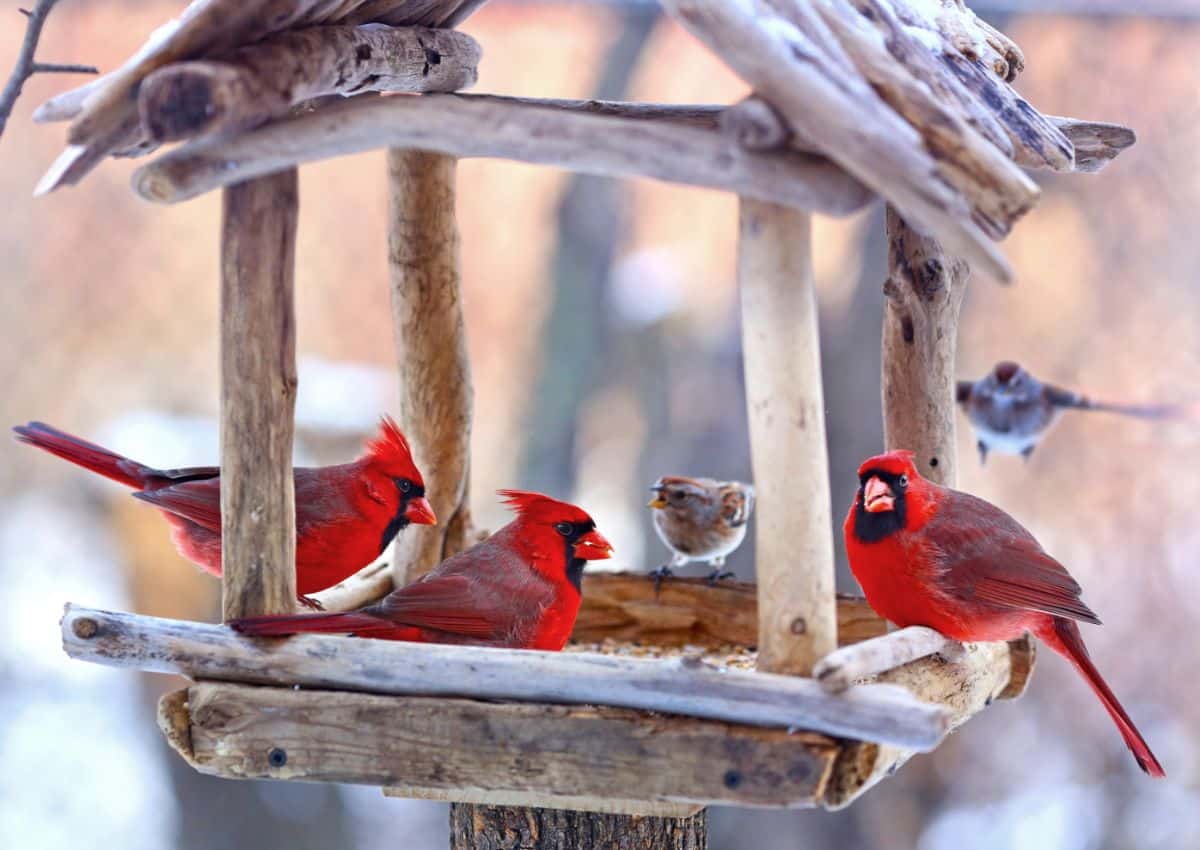
In the wild, cardinals feed on an assortment of berries, insects, nuts, and seeds. But when the winter snows start falling, natural foods become scarce, and cardinals and other birds rely more heavily on the food in bird feeders.
Making sure wild birds, like cardinals, have food, water, and shelter during the winter season will help these birds survive, but it will also lure more colorful birds to your feeders for your winter birdwatching fun!
1. Use the right feeders.
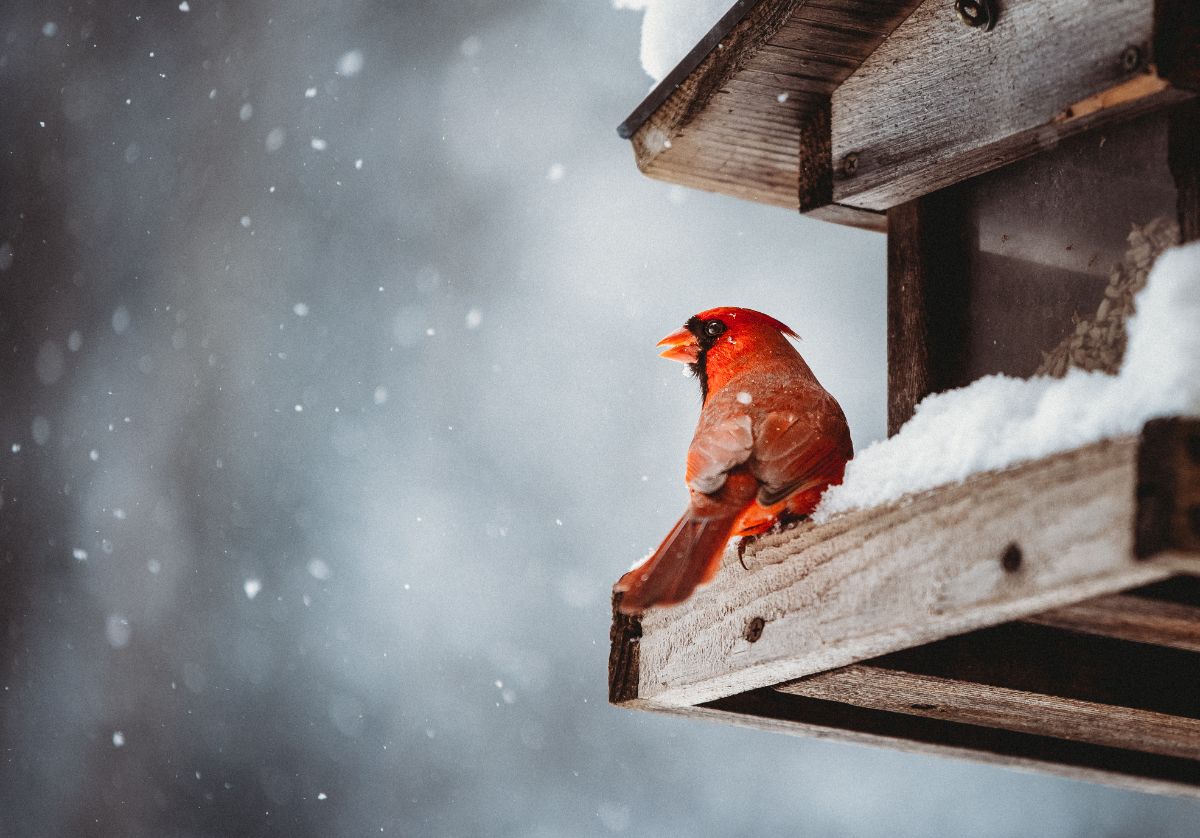
Goldfinches and other small birds can easily perch on slender sock and tube feeders; however, cardinals have a hard time accessing seeds stored in these varieties of bird feeders. Compared to other wild bird species, cardinals are quite weighty, and they have broad breasts, which makes it hard for them to navigate tight feeding spaces. That’s why if you want to feed cardinals in winter, you’ll need to select bird feeders that are an appropriate size for these showy songbirds!
The best types of feeders for cardinals are sturdy platform or hopper feeders, which have a spacious perching spot and large seed trays that make it easy for cardinals to feed. Cardinals also love gobbling up seeds right on the ground, so you may want to scatter a handful or two of seeds beneath your feeders just for cardinals each time you fill up your feeders.
Bird feeders that are mounted to strong supports and stands are also recommended for cardinals; however, small, lightweight, free-hanging feeders are not ideal for feeding cardinals since these types of feeders move too much when cardinals land on them!
2. Feed at the right time.
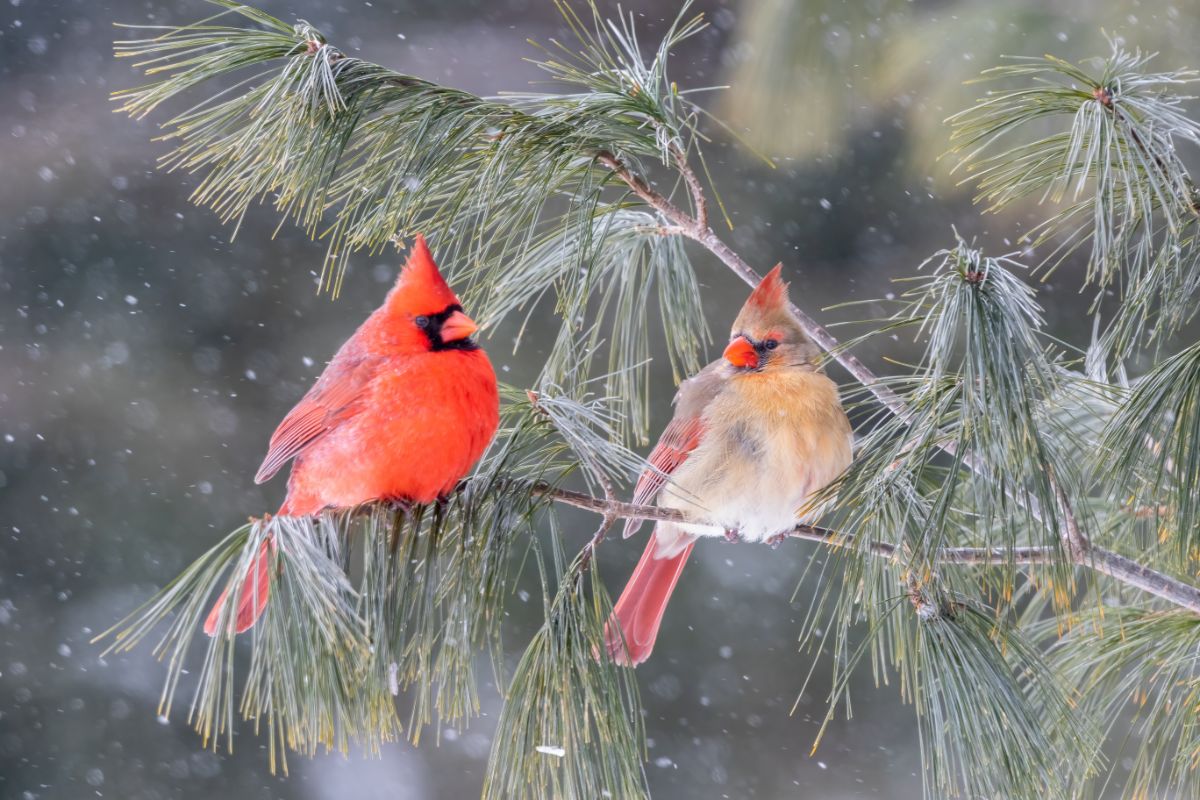
Some birds visit feeders throughout the day, but cardinals are a bit more particular with their feeding habits. If you’ve ever taken the time to observe your bird feeders throughout the course of the day, you may have noticed that cardinals are most active in the early morning and in the evening, immediately before the sun sets. Ensuring that your bird feeders are full at these times of the day will help to provide much-needed food for cardinals even in the depths of winter.
Bird feeders are pretty active places, and if you have a large population of critters in your garden, you may need to fill up your feeders every day. If this is the case, double-check that your feeders are filled at the appropriate times of the day so that cardinals will always have something good to eat. That said, if you know you have rats and other rodents active on your property, you may want to stow your feeders away at night in a metal trash can or other rodent-proof place to avoid attracting unwanted visitors!
3. Pick the right seeds.
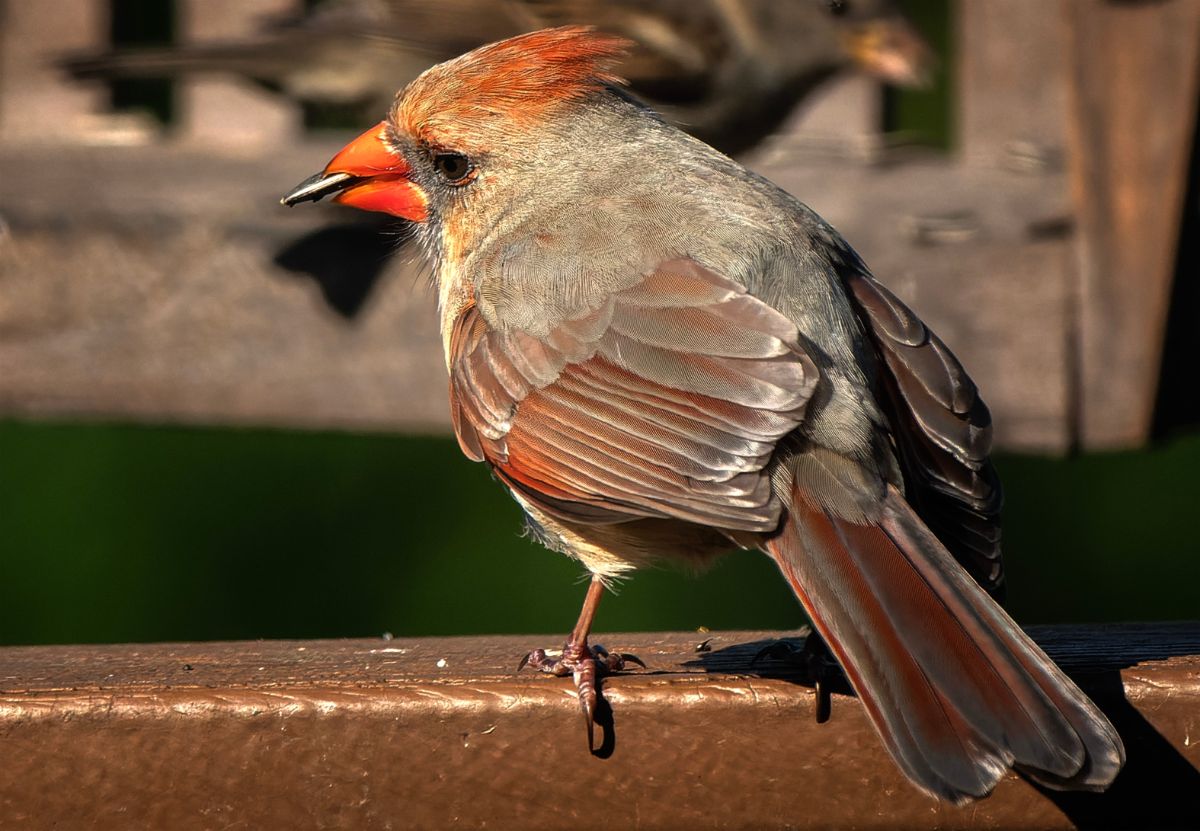
Wild cardinals forage for many different foods in the wild, including nuts, seeds, insects, and berries. But as the winter season progresses, wild foods become scarce, and it becomes increasingly important to put out bird seeds to help wild birds survive the winter. When it comes to cardinals, these birds aren’t particularly fussy eaters, and they will feast on a wide array of foods; however, cardinals are known to favor certain seeds over others!
If your goal is to attract cardinals to your feeders, make sure you have plenty of black oil sunflower seeds on hand. These seeds are rich in calories, and they contain a lot of oil, which can help cardinals stay warm on chilly winter nights. Black oil sunflower seeds are also highly attractive to many other wild birds, including chickadees, titmice, grosbeaks, finches, and catbirds.
Aside from black oil sunflower seeds, cardinals are also lured in by other large seed types, including white milo and safflower seeds. Cardinals also love crushed peanuts, cracked corn, dried mealworms, berries, and suet. Depending on your interests and budget, you can provide these foods separately in individual feeders, or you can make your own cardinal seed blend by mixing these ingredients together; however, you can also find pre-made bird seed mixes that are specially formulated for cardinals!
4. Provide fresh water.

Just like food resources, fresh water becomes harder to find in winter. So, if you want to attract cardinals and other birds to your property, you’ll need to provide a water resource or two. And if you happen to live in an area where the ground freezes, you’ll need to ensure that that water resource doesn’t freeze solid!
Bird baths that are at least 2” deep are the most reliable way to provide water to cardinals in winter. But if you live in a cold area, you may want to install a bird bath defroster, too. These handy devices keep water temperatures just above freezing, but they don’t run constantly, so they can help conserve energy.
Aside from a defroster or bird bath heater, you may also want to install a bubbler or solar fountain in your bird bath. These devices are less necessary in winter gardens, but cardinals are known to be more attracted to running water.
5. Put your feeding station in the right spot.
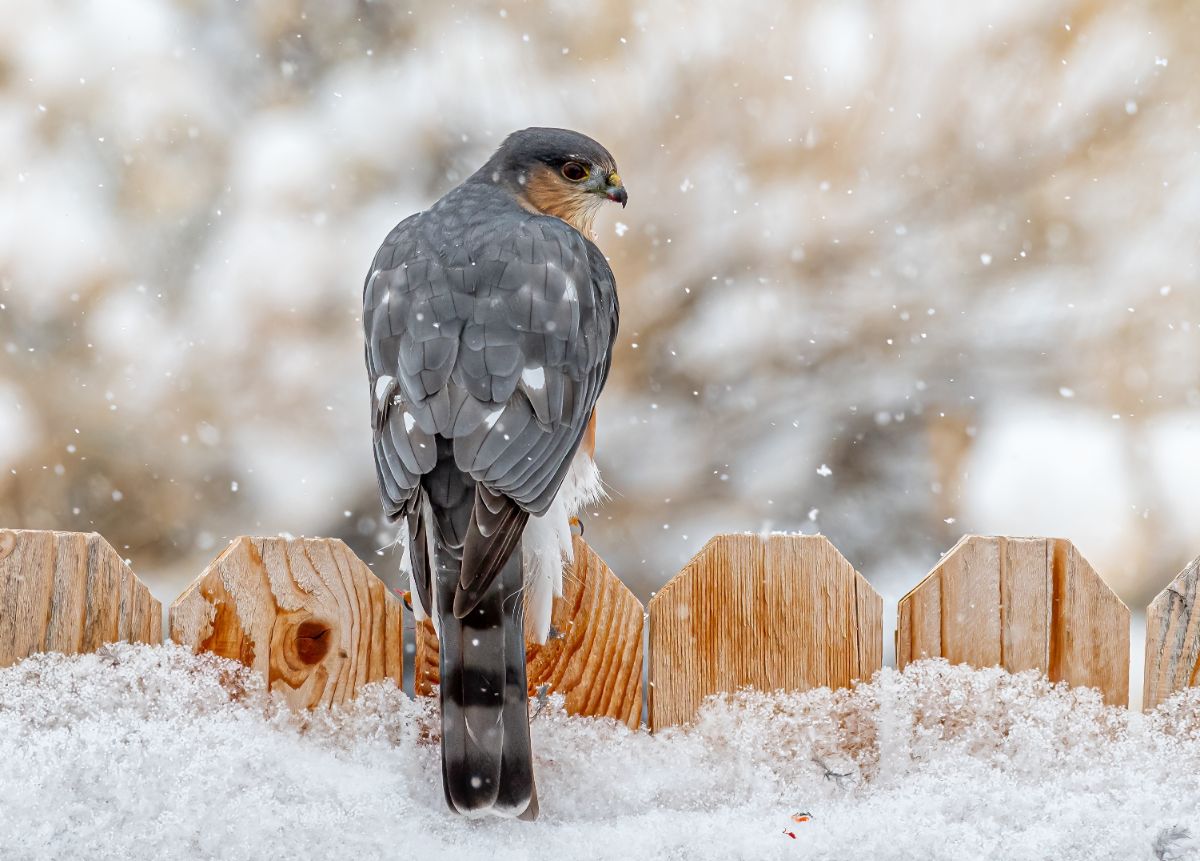
Birdwatchers adore cardinals for their fire engine red feathers. But as unique as cardinal feathers are, they do have one significant drawback. Cardinals’ conspicuous coloration makes these birds easier for predators to spot.
Hawks, falcons, and other birds of prey often target cardinals, so cardinals have learned to hang out in dense thickets and evergreen tree branches, which help ward against aerial attack. When you’re finding a spot for your bird feeders, keep this in mind and locate your feeders in a part of your yard that has some extra protection.
Placing a feeder beneath tree branches can help keep hawks from swooping in, or you can mount a bird feeder on the side of your home or near shrubs so that if problems do arise, cardinals will be able to make a hasty retreat into safety!
6. Be consistent.
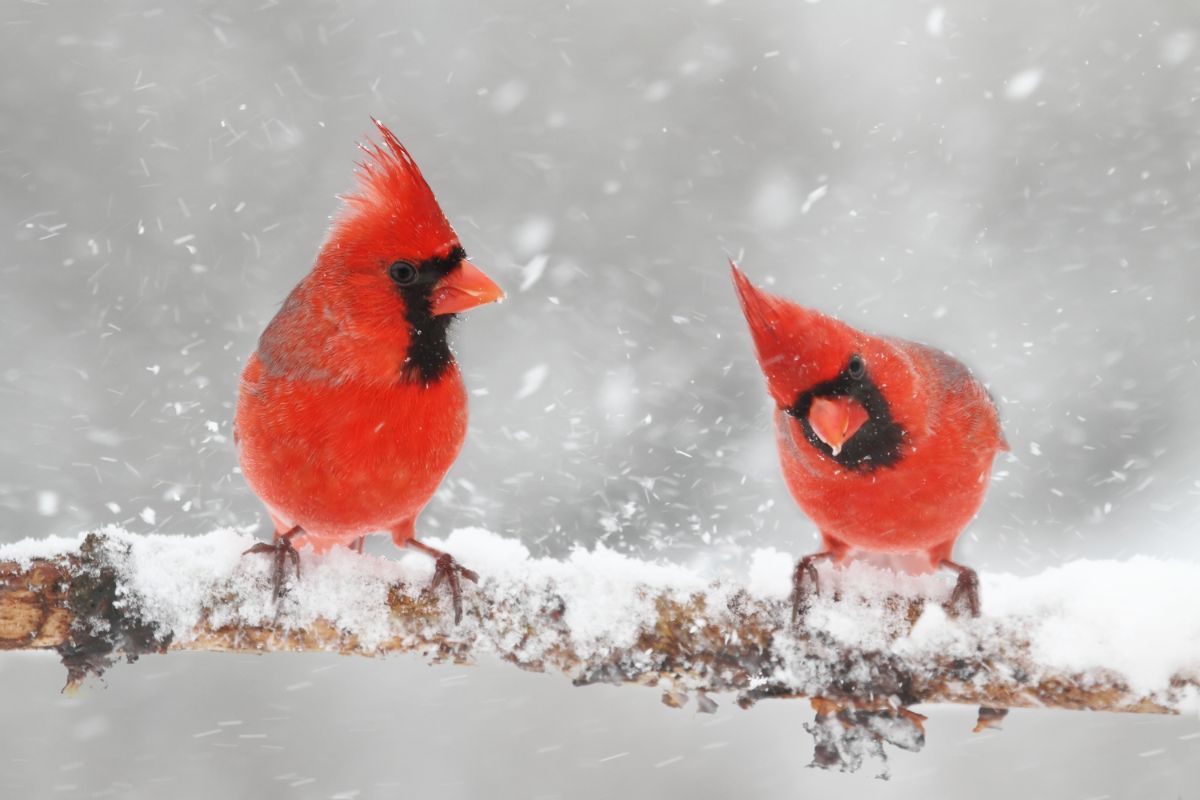
Like many other animals, cardinals are creatures of habit, and they tend to visit the same food and water resources throughout the year. Providing food for wild birds on occasion is helpful, but if you want cardinals to stick around your garden, make sure you fill up your feeders regularly. Depending on how many birds visit your garden, you may need to fill up your feeders once a day or even more.
While feeding birds does take a commitment, it is a rewarding experience that can bring a lot more wildlife activity to your garden. You can make feeding birds even more enjoyable by setting up a cozy seating spot for yourself by your window with a comfy chair and a pair of binoculars so you can watch all the excitement happening at your feeders. You may even want to pick up a nature journal so you can keep track of what birds you see and when they visit, and then you can share your sightings with other birding enthusiasts!
7. Grow winter interest plants.
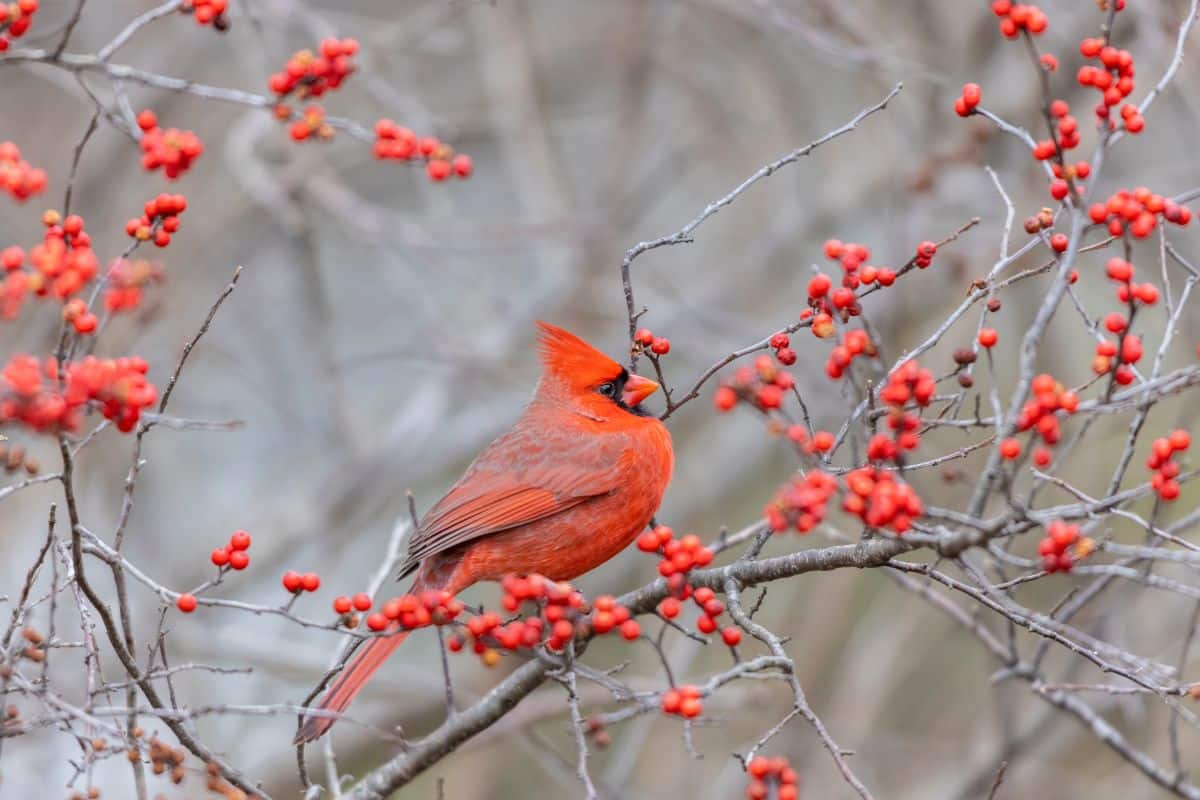
If you have a small garden space and want to attract birds, installing a bird feeder or two is the way to go. But if you have a spacious garden and want to make your landscape even more irresistible to cardinals, you may want to go the extra mile and grow plants specifically for these birds!
Cardinals and other birds typically shelter in dense thickets and evergreen shrubs and trees, so be sure to include some native evergreens and densely growing shrubs, like forsythia, in your garden design.
While installing birdhouses can entice some other bird species into your garden, cardinals are typically not interested in birdhouses, but they do love to hide out in plants and trees! Choosing plants, trees, and shrubs with different heights will make a more complex habitat for cardinals, and cardinals may shelter in grapevines and other vining plants, too!
Aside from shelter, cardinals also seek out plants in winter when foraging for wild foods. Seed-bearing plants, like sunflowers, can be left in your garden over the winter to provide food sources for cardinals and other critters. Or you can grow winter interest shrubs that produce colorful berries to feed cardinals as well as other songbirds.
Some of the best winter interest plants to grow for cardinals include:
- Evergreens
- Grapevines
- Winterberry
- Juniper
- Virginia creeper
- Chokecherry
- Hawthorn
- Staghorn sumac
- Dogwood
- Cotoneaster
8. Keep cats indoors.
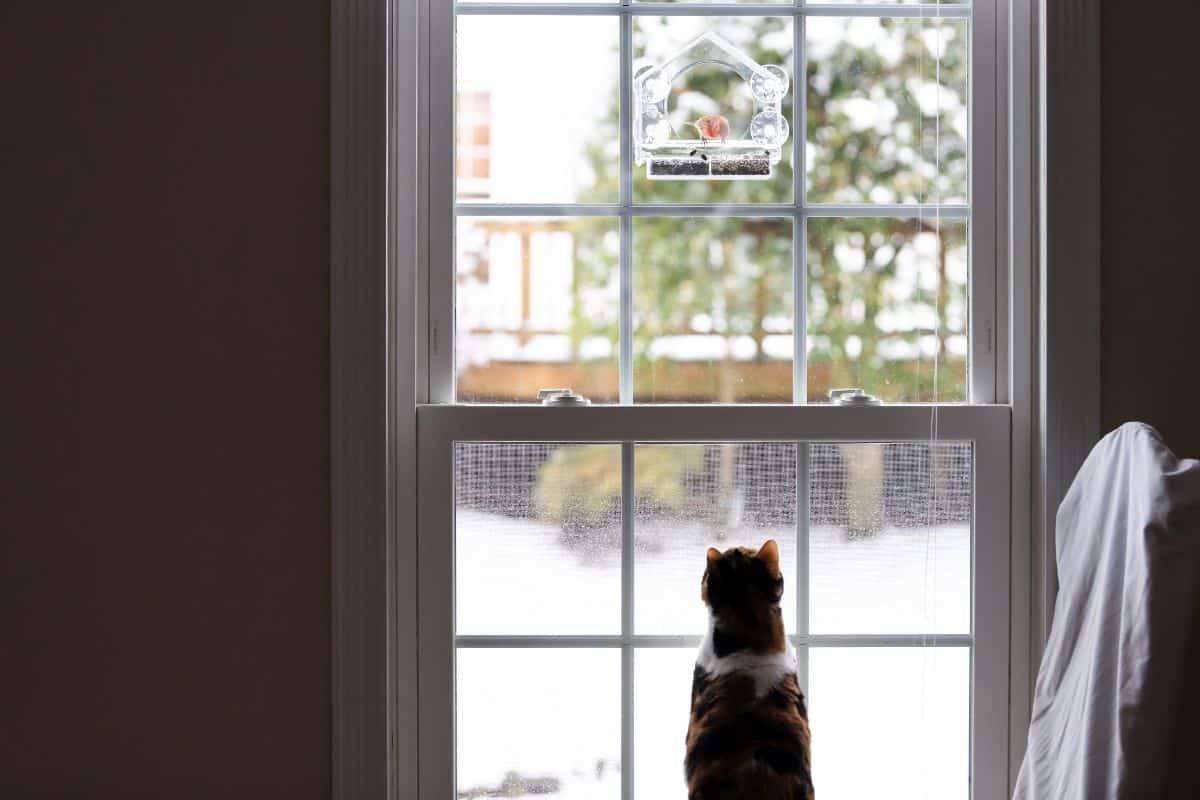
Cats are charming companions, and they help to keep rodents out of our homes, too. But as anyone can tell you, cats can be ferocious predators, and they don’t differentiate much between gobbling up unwanted mice and hunting local songbirds. That’s why if you want to attract cardinals and other birds to your winter garden, it’s best to keep Fluffy indoors!
When cats are left to roam outdoors, they will often eat birds like cardinals. But even if your friendly feline doesn’t have hunting skills, the scent of cats can keep birds from visiting! If your kitty is insistent on having some outdoor playtime, consider investing in a “catio” or make your own outdoor cat play space that will keep your cats and wild birds safe, too!
9. Avoid reflective surfaces.
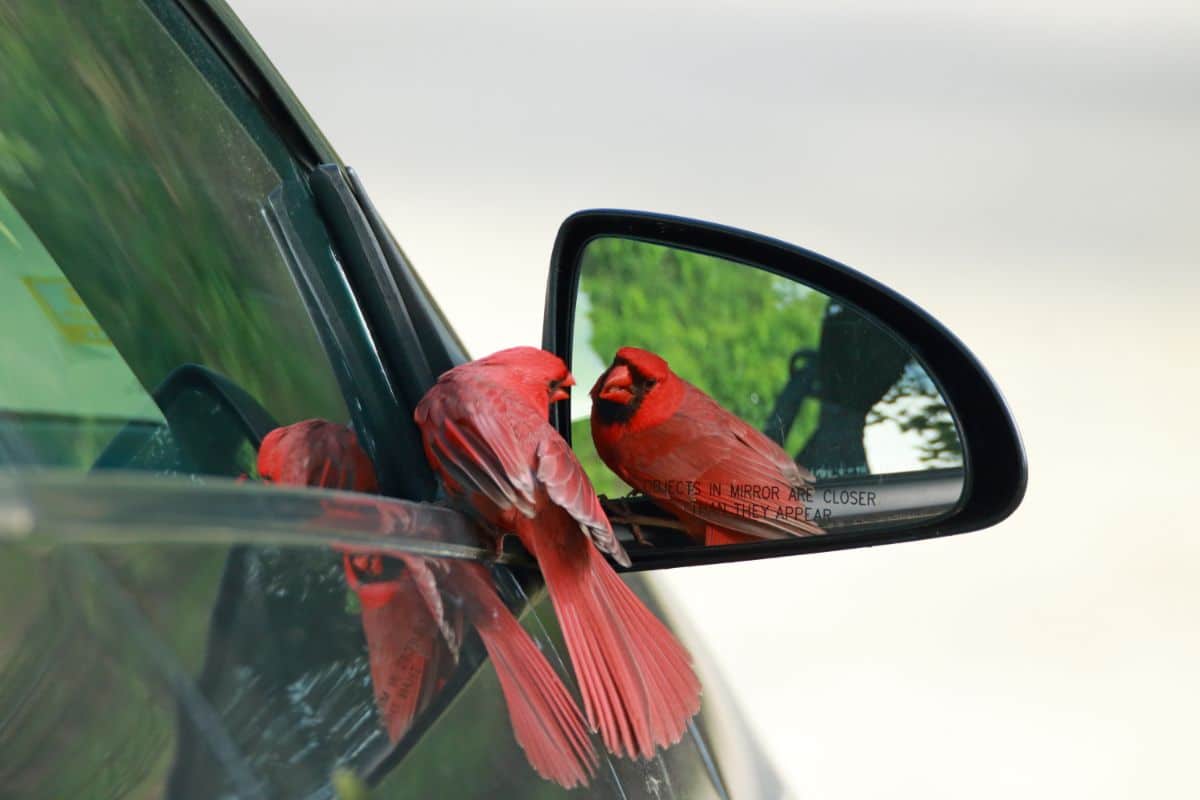
Male cardinals can be territorial creatures that may attack their own reflections. While this can be a perplexing activity to watch, it may also endanger cardinals. At times, cardinals may injure themselves by flying into a mirror or window in their attempt to chase away what they believe is a rival cardinal!
One way to help protect cardinals in your garden is to stick anti-collision decals on your windows, or you can leave screens in place, which will provide some buffer against window strikes. If cardinals seem to be particularly attracted to your car mirrors, you want to keep your car mirrors covered when your car isn’t in use. There is also some evidence that basic highlighter markers can be used to keep birds from striking windows as well!
10. Go organic.
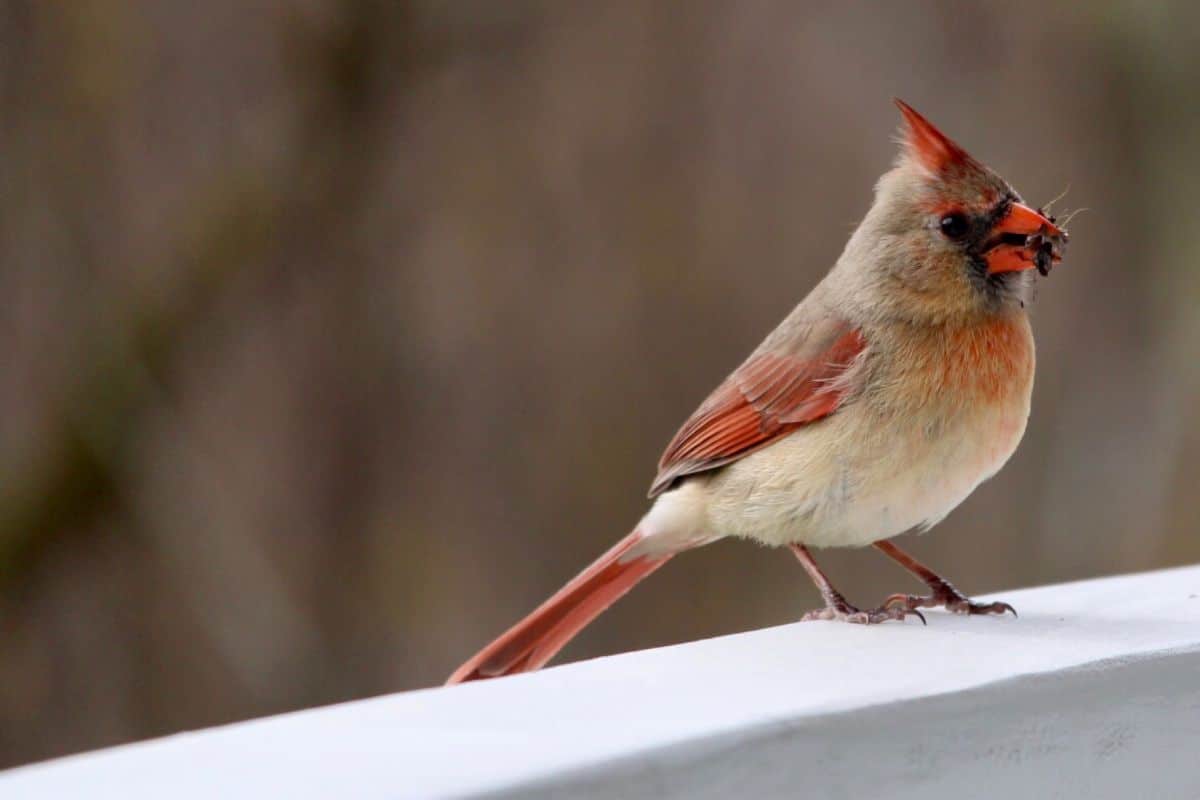
During the summer months, cardinals and other birds feed on insects, as well as plants. While insects are less common in winter, some insects will emerge during warm spells, and they can provide a protein-packed treat for birds in winter. But if you use pesticides in your garden, insects will be much more scarce, regardless of the time of the year.
Because insects are such an important food source for birds, if you want to attract cardinals to your garden, it’s best to keep your lawn and garden as organic as possible. That means opting for organic pest control methods, like floating row covers and crop rotation, whenever possible and feeding plants with organic fertilizers, compost, and worm castings.
You can also apply natural mulches, like weed-free straw mulch, around the base of your plants as these mulches protect plant roots, but they also serve as habitats for predatory insects, and they make excellent foraging places for wild birds as well!
Frequently asked questions
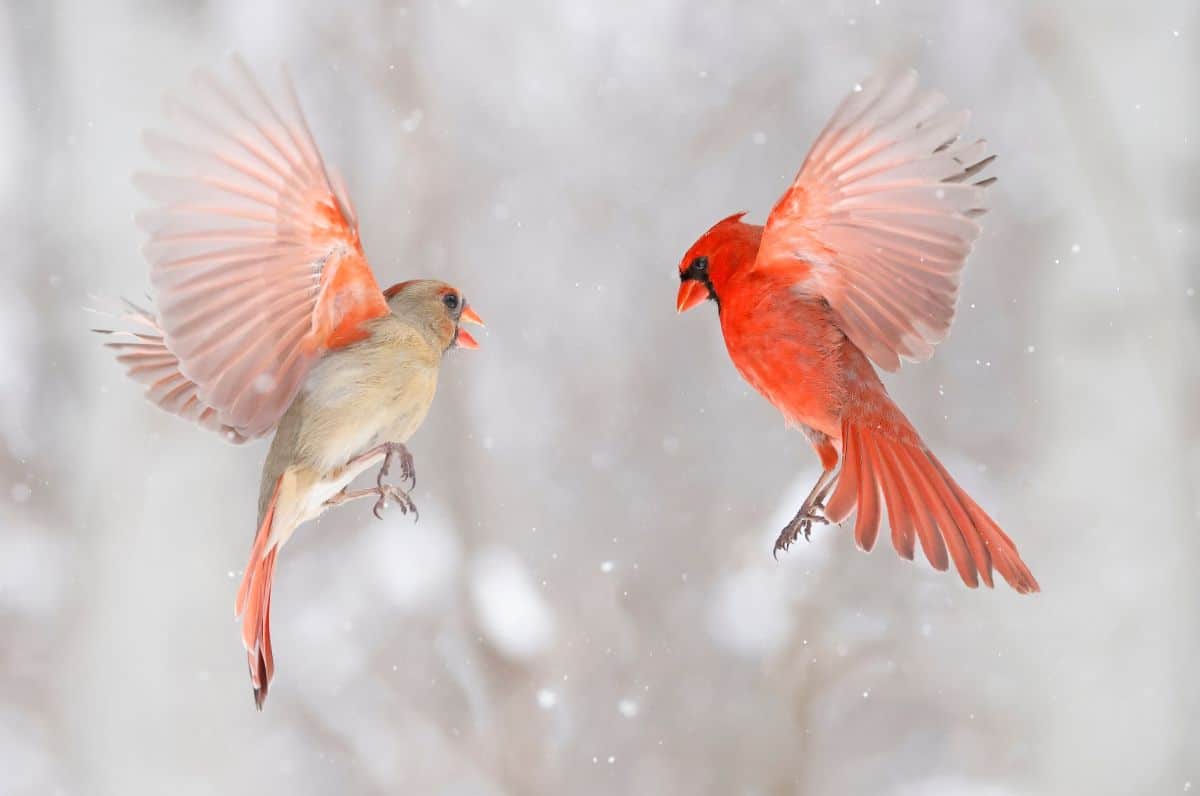
What do cardinals look like in the winter?
Cardinals molt at the end of summer and into early autumn. During this time of the year, their distinct red plumage can look a bit dull and drab. But by winter, all of those glorious new cardinal feathers will have grown in, and cardinals tend to look brightest at this time of the year!
Where do cardinals go at night in the winter?
Like many other songbirds, cardinals generally nest in the shelter of evergreen trees and dense thickets on long winter nights. While birdhouses may be utilized in winter by some other wild bird species, cardinals are not particularly attracted to these structures, and they prefer to shelter in plants, trees, and shrubs.
Do cardinals mate for life?
Cardinals are monogamous birds, and some cardinals will mate for life. More often, cardinals will select a mate for the year, but they may change partners the following year. Typically, cardinal pairs will produce about two clutches of eggs per year – one in March and one in late May to July.
Why does a cardinal keep trying to get in my window?
Male cardinals can be quite territorial, and they often mistake their own reflections for a rival cardinal! If you see cardinals pecking at or flying into windows or car mirrors, there’s a good chance it’s because a cardinal male is on high alert and thinks he’s spotted another male in his territory. Keeping screens on windows and applying bird-safe window decals to windows and doors can help deter this behavior.
What attracts cardinals the most?
The best way to attract cardinals to your garden is by providing a consistent supply of the foods that cardinals love. Berries, nuts, seeds, and mealworms are all favored by cardinals, but the number one treat for cardinals is black oil sunflower seeds!
How high should a cardinal bird feeder be?
Cardinals generally prefer bird feeders that are hung at about eye level or approximately 5 to 6’ above the ground. That said, cardinals also often feed right on the ground, so you may want to scatter some bird seed beneath your feeders to feed cardinals, too!
Summary
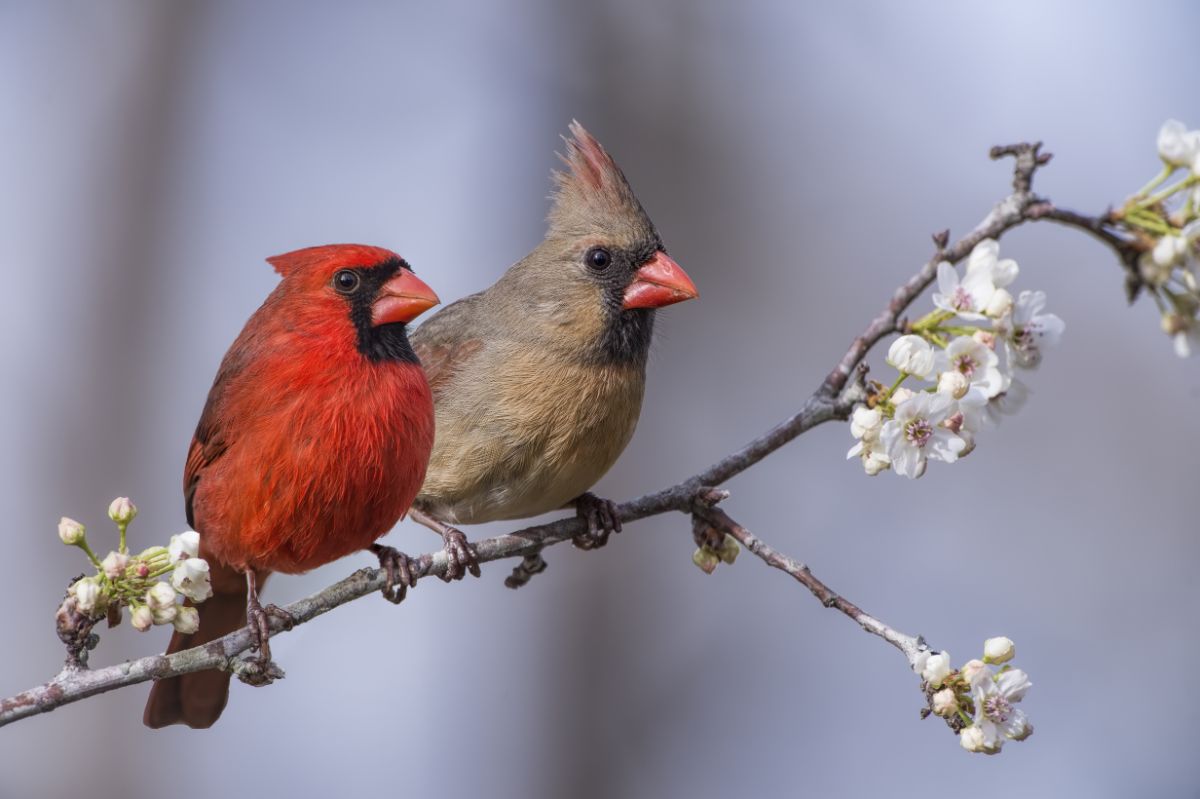
With their crimson feathers and chipper nature, cardinals are always welcome visitors at winter bird feeders. But if you want to attract more cardinals and other birds to your winter garden, you’ll need to provide an assortment of foods, as well as water and shelter.
Once your bird feeders are installed, and your bird bath is defrosting, sit back with your binoculars and a hot cup of cocoa and watch how many cardinals and other birds gather at your feeders winter through spring!
If you want to do even more to help wild birds in winter, check out our guide on how to create a winter bird habitat or discover the best homemade bird treats for feeding cardinals and other birds in winter right here.


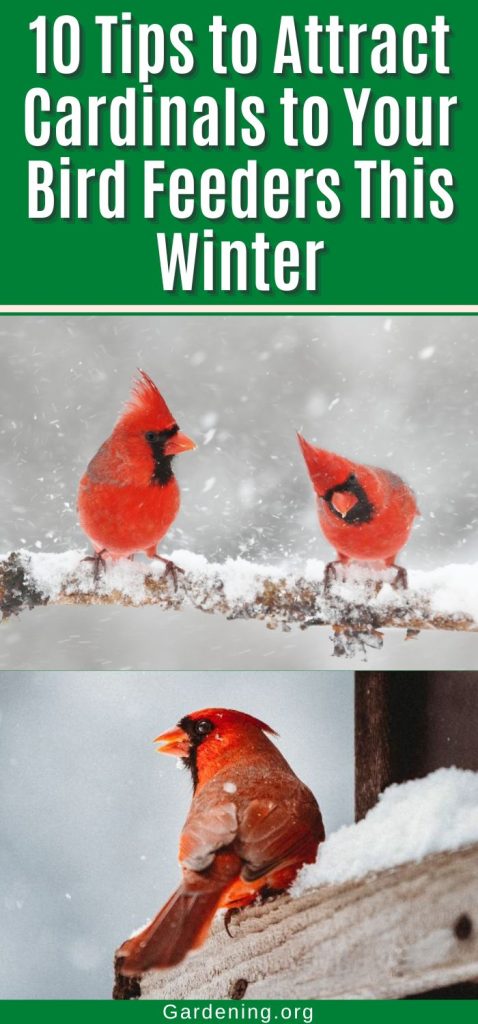
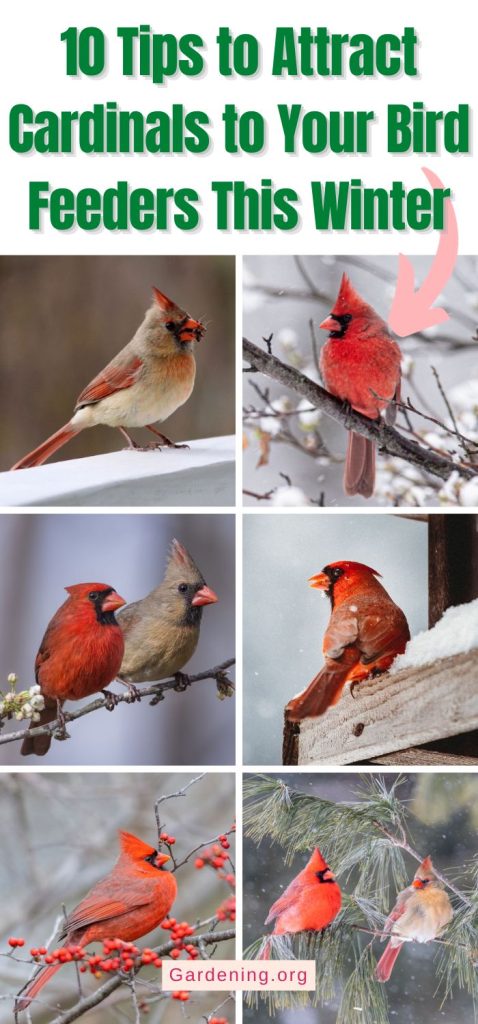
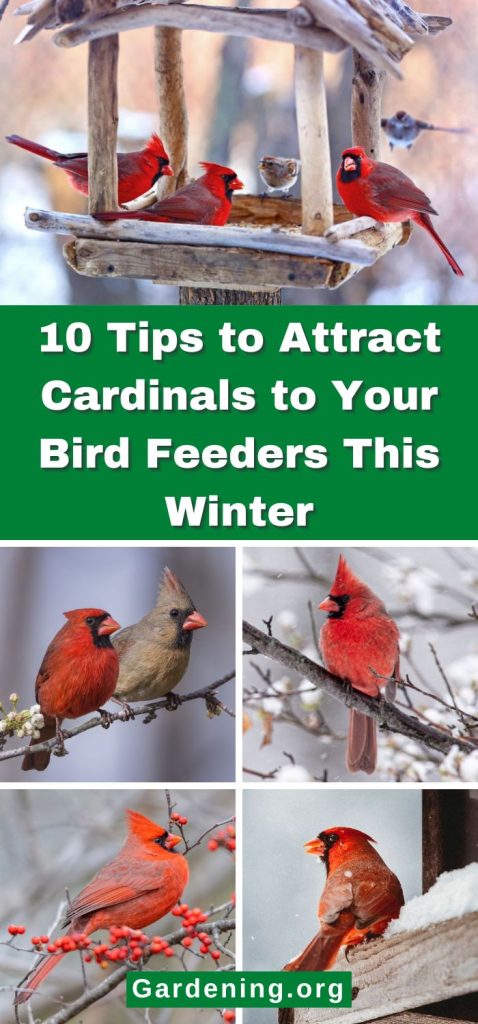




Leave a Reply